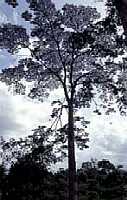DESCRIPTION: It is a fairly large tree, up to 40 m tall. The bole is branchless for up to 20 m and grows to 100 cm or more in diameter, with a spreading flat crown. USE: The bark is used for tanning and in the spring it is used as cattle feed. Leaves are used to feed chickens and goats. The wood is used pulp and paper, fuelwood and charcoal. The comparatively soft timber is suitable for general utility purposes, such as light construction, furniture, cabinet work, lightweight packing materials and pallets, and chopsticks. The tree is suited for erosion control, shade and shelter and reforestation, and it nodulates and fixes atmospheric nitrogen. Also grown as an ornamental. GROWING PERIOD: Perennial. COMMON NAMES: albizia, Indonesian albizia, moluca, paraserianthes, peacock plume, white albizia. FURTHER INF: It is native to the Admirality Islands, the Moluccas, New Guinea, the Solomon Islands and the eastern Malesian area where as the largest diversity is found here. It is widely planted throughout the tropics. It is a pioneer species and occurs in primary and secondary lowland rainforest and in light mountain forest, grassy plains and along roadsides near the sea. It is adapted to peri-humid and monsoonal climates with a dry season of up to 2-4 months. It is sensitive to fire and easily damaged by strong wind.
|
